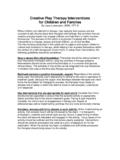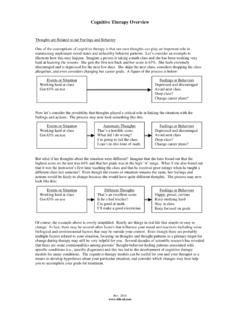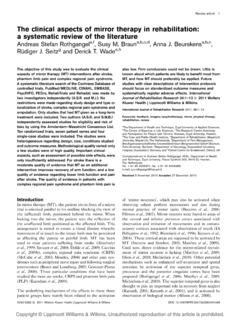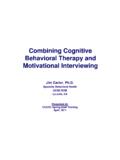Transcription of Intersubjectivity: The core of effective therapeutic ...
1 intersubjectivity : The core of effective therapeutic parenting and therapy Arthur Becker-Weidman, , Center For Family Development 716-810-0790 In this article I d like to briefly outline the concept of intersubjectivity . The intersubjective sharing of experience is a concept that has significant power for understanding relationships, interactions, and treatment (in this article I use the term treatment to refer to psychotherapy and therapeutic parenting ). intersubjectivity is a process that occurs within all relationships at all times. As I will describe, it can be concordant or discordant; in or out of sync, enhancing or denegrating.
2 One element of intersubjectivity is attunement or shared emotion. While attunement is a necessary condition for therapeutic work, it is not sufficient. One can have a high degree of attunement with another and still have a discordant relationship fraught with tension and miscues. For example, you may understand and know that your child is angry because you said no to your child having a cookie right before dinner. You may further appreciate that because of the child s history of having been starved, any no regarding food sets off a tantrum because of the child s fear of starvation.
3 You may be in perfect attunement with your child at that point, yet the tantrum still is that? If we use the concept of intersubjectivity , we will see why this occurs and how attunement is only one dimension of the relationship that needs to be in sync for there to be a better outcome. intersubjectivity has three components: 1. Shared emotion (attunement). 2. Shared attention 3. Shared intention Now we can see how the above interaction may have gone badly. While the parent may have shared emotion and deeply felt the child s anxiety and fear about going hungry, one of the other components was out of sync.
4 The child s attention may have been focused on the food and cookie while the parent s attention was on trying to avoid a tantrum right before dinner time. Or, the child s intention was on eating and eating now, while the parent intended to explain how eating cookies now would spoil dinner and explaining to the child that it would be ok because we could have the cookies for desert. The intersubjective sharing of experience can be concordant or in sync, or discordant; either not in sync or in opposition. An example of concordant intersubjectivity is the clip of Jordan and his grandfather in the wonderful tape by Johnson & Johnson, The Amazing World of the Newborn.
5 A simple example of concordant intersubjectivity is when you and another are playing a game together. You both share the excitement of the game (the roll of the dice or play of the ball) (shared emotion), both are focused on playing the game (attention) and on how each is playing while you each try to win or each just play to have fun (concordant intention). In this example, suppose you are playing racket ball. But now, you are playing to win the game and your friend is playing just to have experience may be less than satisfying for each of you. You both share the excitement of the game (emotion) and are both paying attention to the play of the game (attention), but now your have differing intentions.
6 The central role of intersubjectivity in human development is being increasingly understood by developmental theorists (Trevarthen, 2001; Stern, 1985). intersubjectivity is the shared, reciprocal, experience between the parent and child whereby the experience of each is having an impact on the experience of the other. For example, children experience themselves as being loved, loveable, valued, valuable, and clever whenever their parents experience them as manifesting those characteristics. In a similar way, parents experience themselves as being capable and caring whenever their children experiences them as manifesting those traits.
7 It is very difficult, if not impossible, to experience oneself as possessing these traits if the important people in our lives do not experience us as having those traits. intersubjectivity is not a process whereby the parent (or therapist) evaluates the child (or client) as possessing a trait and then presents a verbal summary of the evaluation. intersubjectivity represents a comprehensive emotional, intentional/motivational, attentional, reflective, and behavioral experience of the other. It emerges from shared emotions (attunement), joint attention and awareness, and congruent intentions.
8 The psychiatric diagnosis Reactive attachment disorder (RAD) (DSM-IV-R ) can be understood as the result of significant impairment in the intersubjective sharing of experience between caregiver and child. This discordant intersubjectivity results in impairment in core social, psychological, and interpersonal domains. RAD may be best understood within the framework of intersubjectivity (Trevarthen, C., 2001, Diamond, N., & Marrone, M., (2003), which has a central role in the healthy development of brain systems (Shore, 1994), social functioning, and interpersonal relationships.)
9 Therefore, treatment should focus on these domains of impairment. Specifically, one would expect effective treatment to focus on the intersubjective sharing of experience and on relationship processes. Children with chronic histories of early maltreatment within a caregiving relationship are at particular risk of developing RAD and have impairment in several domains, which has been broadly defined as complex trauma. Treatment for RAD that focuses on intersubjectivity , which has a central role in the development of brain and social functions, is suggested as the preferred approach.
10 I would argue that effective treatment requires an affectively attuned relationship characterized by concordant intersubjectivity . Siegel (1999) stated, As parents reflect with their securely attached children on the mental states that create their shared subjective experience, they are joining with them in an important co-constructive process of understanding how the mind functions. The inherent feature of secure attachment contingent, collaborative communication is also a fundamental component in how interpersonal relationships facilitate internal integration in a child.









